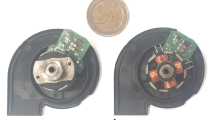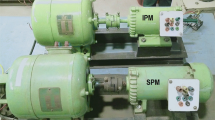Abstract
This paper investigates the electromagnetic and structural characteristics of a spoke type BLDC motor and provides a comparative study with respect to Interior Permanent Magnet motor (IPM).The electromagnetic analysis aims to determine the average torque and cogging torque of spoke type BLDC motor. The natural and induced vibration characteristics of the motor are evaluated by performing structural finite element analysis. The electromagnetic and vibration characteristics are assessed for different slot/pole combination to provide an insight on their influence on the performance of the motor. In addition, thermal analysis is performed to predict the temperature distribution and a comprehensive analysis of spoke type BLDC motor is presented.


















Similar content being viewed by others
References
Demmelmayr F, Weiss B, Troyer M, Schroedl M (2013) Comparison of PM machines with ferrite and NdFeB magnets in terms of machine performance and sensor less startup control. In: IEEE international conference on industrial technology (ICIT), pp 272–277
Kang GH, Hur J, Sung HG, Hong JP (2003) Optimal design of spoke type BLDC motor considering irreversible demagnetization of permanent magnet. In: International conference on electrical machines and systems, pp 234–237
Kim HW, Kim KT, Jo YS, Hur J (2013) Optimization methods of torque density for developing the neodymium free SPOKE-type BLDC motor. IEEE Trans Magn 49(5):2173–2176
Kim S, Cho J, Park S, Park T, Lim S (2013) Characteristics comparison of a conventional and modified spoke-type ferrite magnet motor for traction drives of low-speed electric vehicles. IEEE Trans Ind Appl 49(2):2516–2523
Hwang KY, Rhee SB, Yang BY, Kwon B (2007) Rotor pole design in spoke-type brushless DC motor by response surface method. IEEE Trans Magn 43(4):1833–1836
Jafarishiadeh S, Ardebili M, Marashi AN (2016) Investigation of pole and slot numbers in axial-flux PM BLDC motors with single-layer windings for electric vehicles. In: 24th Iranian conference on electrical engineering (ICEE), pp 1444–1448
Jafarboland M, Farahabadi HB (2017) Structural design for vibration reduction in brushless DC stator. J. Electr. Eng. Technol. 12(5):1848–1850
Sashidhar S, Fernandes BG (2017) A novel ferrite SMDS spoke-type BLDC motor for PV bore-well submersible water pumps. IEEE Trans Industr Electron 64(1):104–114
Hur J, Reu JW, Kim BW, Kang GH (2011) Vibration reduction of IPM-type BLDC motor using negative third harmonic elimination method of air-gap flux density. IEEE Trans Ind Appl 47(3):1300–1309
Chen YS, Zhu ZQ, Howe D (2006) Vibration of PM brushless machines having a fractional number of slots per pole. IEEE Trans Magn 42(10):3395–3397
Sun T, Kim JM, Lee GH, Hong JP, Choi MR (2011) Effect of pole and slot combination on noise and vibration in permanent magnet synchronous motor. IEEE Trans Magn 47(5):1038–1041
Seo J (2013) Investigation on performance characteristics of IPM for electric vehicles considering driving conditions and pole-slot combinations. J Magn 18(3):268–275
Valavi M, Nysveen A, Nilssen R, Lorenz RD, Rolvag T (2014) Influence of pole and slot combinations on magnetic forces and vibration in low-speed PM wind generators. IEEE Trans Magn 50(5):1–11
Lee BK, Kang GH, Hur J, You DW (2004) Design of spoke type BLDC motors with high power density for traction applications. In: Conference record of 2004 industry applications conference, pp 1068–1074
Mohammad MR, Kim KT, Hur J (2013) Design and analysis of a spoke type motor with segmented pushing permanent magnet for concentrating air-gap flux density. IEEE Trans Magn 49(5):2397–2400
Jeong C, Hur J (2016) A novel proposal to improve reliability of spoke-type BLDC motor using ferrite permanent magnet. IEEE Trans Ind Appl 52(5):3814–3821
Ozoglu Y, Garip M, Mese E (2005) New pole tip shapes mitigating torque ripple in short pitched and fully pitched switched reluctance Motors. Electric Power Syst Res 74:95–103
Kim S-I, Park S, Park T, Cho J, Kim W, Lim S (2014) Investigation and experimental verification of a novel spoke-type ferrite-magnet motor for electric-vehicle traction drive applications. IEEE Trans Ind Electron 61(10):5763–5770
Fan J, Zhang C, Wang Z, Dong Y, Nino CE, Tariq AR, Strangas EG (2010) Thermal analysis of permanent magnet motor for the electric vehicle application considering driving duty cycle. IEEE Trans Magn 46(6):2493–2496
Jing L, Gong J (2020) Analytical model and optimization design of surface-mounted PM motors with Halbach arrays accounting for semi-closed slots. IET Electr Power Appl 14(11):2074–2081
Cassat A, Espanet C, Wavre N (2003) BLDC motor stator and rotor iron losses and thermal behavior based on lumped schemes and 3-D FEM analysis. IEEE Trans Ind Appl 39(5):1314–1322
Bai J, Zheng P, Tong C, Song Z, Zhao Q (2015) Characteristics analysis and verification of the magnetic-field-modulated brushless double-rotor machine. IEEE Trans Ind Electron 62(7):4023–4033
Jing L, Pan Y, Wang T, Qu R, Cheng P-T (2021) Transient analysis and verification of a magnetic gear integrated permanent magnet brushless machine with Halbach arrays. In: IEEE journal of emerging and selected topics in power electronics, pp 1
Lee ST (2009) Development and analysis of interior permanent magnet synchronous motor with field excitation structure, Ph.D. Thesis, University of Tennessee, Knoxville
Gieras JF (2004) Analytical approach to cogging torque calculation of PM brushless motors. IEEE Trans Ind Appl 40(5):1310–1316. https://doi.org/10.1109/TIA.2004.834108
Author information
Authors and Affiliations
Corresponding author
Additional information
Publisher's Note
Springer Nature remains neutral with regard to jurisdictional claims in published maps and institutional affiliations.
Appendices
Appendix 1
See Table
8.
Appendix 2
In Spoke type BLDC motor the flux is confined to a single closed loop as shown in Fig.
19 and the corresponding magnetic equivalent circuit is shown in Fig.
20. Based on Norton equivalent circuit, the permanent magnet is theoretically represented by a flux source in parallel with an internal permeance [24].
The remanance flux from Permanent magnet is
Magnetic reluctance of Permanent magnet,
If we neglect the leakage at the bridge of the rotor, the air-gap flux density is
Therefore the air-gap flux density can be simply calculated by dividing the air-gap flux by the air-gap surface as
The air-gap reluctance
The average torque is
The torque expression for the spoke type motor is given by the equation
where Rrot is the rotor outer radius, Lu is the stack length,\(\mu_{0}\) is the permeability of free space, Br is radial flux density and Bθ is the tangential flux density of the magnetic field in the air gap.
The cogging torque is expressed as
where w is the magnetic field stored in the air-gap
where bg(x) is the air gap magnetic flux density expressed as a function of the x co-ordinate. The magnetic flux density distribution in the air-gap bg(x), due to permanent magnet bpm and slotted stator core bsl(\(x\)) is given as
For buried permanent magnets such as in Spoke type BLDC motor, the cogging torque [25] is derived as follows
Thus the cogging torque can be computed by using the above equation.
Rights and permissions
About this article
Cite this article
Kurinjimalar, L., Balaji, M., Prabhu, S. et al. Analysis of Electromagnetic and Vibration Characteristics of a Spoke Type PMBLDC Motor. J. Electr. Eng. Technol. 16, 2647–2660 (2021). https://doi.org/10.1007/s42835-021-00807-4
Received:
Revised:
Accepted:
Published:
Issue Date:
DOI: https://doi.org/10.1007/s42835-021-00807-4






